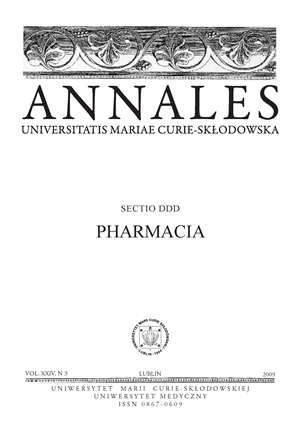Wpływ albuminy z jaj kurzych na uwalnianie witaminy E z kapsułek żelatynowych
Abstrakt
Tematem pracy było zbadanie wpływu lepkości cieczy biorczych składających się z buforu fosforanowego o pH 6,8, zawierających 0,75, 1,5, 3% (w/v) albuminy jaja kurzego z dodatkiem lub bez dodatku 1% (w/v) Tween 20, na profile uwalniania dl-α-octanu tokoferolu z żelatynowych kapsułek. Do opisu uwalniania witaminy E zastosowano kinetyczny model Higuchiego. W celu zbadania wpływu lepkości cieczy biorczych na ilość uwolnionej substancji obliczono pole pod krzywą stężeniowo-czasową (AUDC*) i porównano ze stężeniem albuminy w cieczach biorczych. Stwierdzono, że ilość uwolnionej witaminy E wzrasta wraz ze wzrostem stężenia albuminy i czasem uwalniania. Całkowita ilość uwolnionej witaminy E była największa dla cieczy biorczej zawierającej 3% (w/v) albuminę z dodatkiem 1% (w/v) Tweenu 20, wskazując na pozytywny wpływ dodatku tego emulgatora na uwalnianie witaminy E. W pracy poruszono także temat wpływu niejonowego emulgatora – Tweenu 20 na właściwości roztworów zawierających albuminę oraz możliwość powstawania związków kompleksowych w rezultacie oddziaływań białko – emulgator.
Bibliografia
1. Aburub A., Risley D. S., Mishra D.: A critical evaluation of fasted state simulating gastric fluid (FaSSGF) that contains sodium lauryl sulfate and proposal of modified recipe. Int. J. Pharm. 347, 16, 2007.
2. Bertocchi P., Antoniella E., Valvo L. et al.: Diclofenac sodium multisource prolonged release tablets – a comparative study on the dissolution profiles. J. Pharm. Biomed. Anal. 37, 679, 2005.
3. Chen L. R., Wesley J. A., Bhat tachar S. et al.: Dissolution behavior of a poorly water soluble compound in the presence of tween 80. Pharm. Res. 20, 5, 797, 2003.
4. Derkatch S. R., Levachov S. M., Kuhkudhkina A. N. et al.: Rheological properities of concentrated emulsions stabilized by globular protein in the presence of nonionic surfactant. Colloids and Surfaces A. Physicochemical and Eng. Aspects, 298, 225, 2007.
5. Donato E. M., Mar t ins L. A., Fröehlich P. E., Bergold A. M.: Development and validation of dissolution test for liponavir, a poorly water-soluble drug, in soft gel capsules, based on in vivo data. J. Pharm. Biomed. Analysis, 47, 547, 2008.
6. FP VI: 116, Warszawa 2002.
7. FP VII supplement: 1417, Warszawa 2007.
8. Furlanet to S., Maest relli S., Orlandi n i S. et al.: Optimization of dissolution test precision for krtoprofen oral extended – release product. J. Pharm. Biomed. Anal. 32, 159, 2003.
9. Gohel M. C., Panchal M. K., Jogani V. V.: Novel mathematical method for quantitative expression of deviation from Higuchi model. AAPS Pharm. Sci. Tech. 1(4), 31, 2000.
10. He Z., Zhong D., Chen X. et al.: Development of adissolution medium for nimodipine tablets based on bioavailability evaluation. Eur. J. Pharm. Sci., 21, 487, 2004.
11. Imai T., Nodomi K., Shameen M. et al.: Mutual effect of egg albumin and fatty acids on bioavailability of dl-α-tocopherol. Int. J. Pharm., 155, 45, 1997.
12. Kasperek R., Czarnecki W.: Effect of hydrophilic substances on liberation of quinidine from starch - alginate sphere. Acta Pol. Pharm., 58, 2, 107, 2001.
13. Park S., Choi H.: The effect of surfactants on dissolution profiles of poorly water – soluble acid drugs. Int. J. Pharm., 321, 35, 2006.
14. Rodriguez Nino M. R., Rodriguez Pat ino J. M.: Surface tension of bovine albumin and tween 20 at the air – aqueous interface. JAOCS, 75, 10, 1998.
15. Taylor S. L., Lamden M. P., Tappel A. L.: Lipids sensitive fluorometric metod for tissue tocopherol analysis.11, 530, 1976.
16. Wu D., Xu G., Feng Y., Wang Y., Zhu Y.: Comparative study on interaction of bovine serum albumin with dissymmetric and symmetric Gemini surfactant by spectral method. Colloid Polym. Sci. 287, 225, 2009.
17. Zadymova N. M., Yampol’skaya G. P., Filatova Yu. L.: Interaction of bovine serum albumin with nonionic surfactant Tween 80 in aqueous solutions: complexation and association. Colloid J., 68, 2, 162, 2006.
18. Zimmer Ł., Czarnecki W.: Polysaccharide formulation for improvement of racemic vitamin E bioavailability. Acta Pol. Pharm., 64, 169, 2007.
19. Zimmer Ł., Czarnecki W.: The effect of schortchain polysaccharides on the release of vitamin E from the capsules filled with granules. Annales UMCS, Sectio DDD XVI (18), 151, 2003.
Pobrania
Opublikowane
Numer
Dział
Licencja
Prawa autorskie (c) 2009 Autorzy

Praca jest udostępniana na licencji Creative Commons Attribution-NonCommercial-NoDerivatives 3.0 Unported License.


